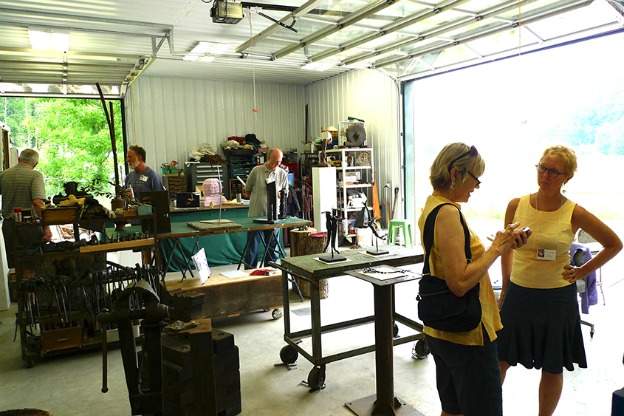
Usually, visual art is appreciated at the end of the creative process.
"Any time you see artwork it's either in an exhibit or a gallery, or some other formal setting," explains artist Mary Uthuppuru.
One art event in Bloomington, however, seeks to bring viewers back into the process by inviting them into artists' studios.
As an artist you have convince yourself that what you're doing is valuable every day. But knowing that there are people in the community who are excited about what you do is something that I can run on for an entire year.
"We have finished work, unfinished work; our tools are all around us; it's a very approachable setting to start a conversation about art workwhy do you make it, how long does it take you, why you even appreciate art in the first place."
Uthuppuru, a maker of art books, is one of 37 artists eager to tackle those questions from visitors to her studio during the Bloomington Open Studios Tour, also known as BOST (pronounced with a long "o"). For its fifth roll-out, the tour is placing a particular emphasis on revealing the artmaking process.
"One of our initiatives this year is a requirement that all of our artists demonstrate their work," explains blacksmith Michal Ann Carley, who makes sculpture and jewelry.
That requirement will have to be modified in her case.
"I can't have a big fire and sparks flying around so I will have a variety of different stages of the work so that people can see how it's done. I can pseudo-demonstrate hitting a hammer on the anvil."
Seeing The Sparks Fly
Giving visitors a chance to see the sparks fly – even figuratively – gives visual art a boost that might allow more people to connect with it. Organizers are launching two other strategies this year for the same reason. They'd noticed that a lot of people in past years used the tour as an excuse for a bike ride. A map developed in tandem with a local bike shop suggests safe routes from studio to studio, and incentivizes cyclists with prizes. And for everyone else, there's a mobile app.
I have appreciated knowing the people who buy my work. Personally I find that incredibly meaningful.
"We wanted to give people a chance to navigate the tour the way they navigate the rest of their lives," Uthuppuru explains. "They can favorite any artist they like, and so they can format their own tour based on how they want to experience it."
To hear tour veteran Elizabeth Busey describe it, BOST sounds almost like trick-or-treating for grown ups.
"You know, there are 400 houses in our section of the neighborhood," the printmaker elaborates, "so unless you have a child or a dog of a similar age, you don't know those people. And they all come in and they say, 'Oh, I live over here, I didn't know you were an artist.' So I'm not sure if they enjoy art, were out for a walk, were just curious, wondered if my house were for sale, all myriad of reasons."
Investing In The Local
Clearly, BOST is a fun way to meet neighbors, and to structure a bike ride, but what's really in it for the artists? Is this the best way to target an art-buying clientele? Not every local artist would agree. A number of Bloomington-based artists whose names never show up on the tour have gallery representation in hubs such as Chicago and New York. Clearly there are disparate philosophies among area artists about the value of maintaining or cultivating a local presence.
"I have appreciated knowing the people who buy my work," explains Busey. "I actually deliver it to their house and help hang it on the wall. Personally I find that incredibly meaningful. I think for a lot of artists that's valuable and feeds their creativity in a way that would be difficult if I just got a call from a gallery that said I sold something."
In order to be relevant, you need to be able to connect with somebody elseyour audience or your fellow artists.
"The people in the Open Studios Tour want to connect with their audience," explains Carley. "I mean Elizabeth writes a blog that she publishes every week precisely with the goal of helping her audience understand what the work is about. And I think that is something that is very current. That's a movement. That is, a desire to be relevant. And in order to be relevant, you need to be able to connect with somebody elseyour audience or your fellow artists. I'm not just going to just work in isolation[where] I finish a piece and I put it there and I look at it nobody else has to look at it."
"As an artist you have convince yourself that what you're doing is valuable every day," admits Uthuppuru. "And that's a tough battle. But if you know that there are people in your community who are excited about what you do, and each time I see them their eyes light up because I showed them something they didn't see before, that's something that I can run on for an entire year."
Of course regular meals help with that, and having the means to light up the studio, along with visitors' eyes. But the tour's mission, Carley explains, goes beyond material concerns.
"We really have walked away from our only goal being to make sales. It will be great when it happens, but we're really trying to build relationships and make the community a better place."






